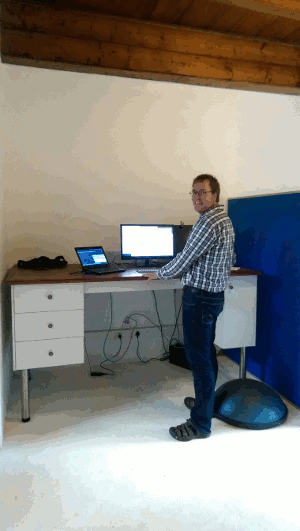Visit South Africa, almost The Big 5
Visit South Africa (SA)
One of the nice things about bigger Open Source projects like QGIS, is that the community is pretty international. So when Tim-QGIS-Sutton me invited for a visit to South Africa with my family,... we visited them and enjoyed SA :-)
Starting of as a holiday, I ended it with two weeks of work in the Swellendam office of Kartoza Tim’s current company.

Richard behind a ‘standing desk’ in Kartoza offices. Wondering what the blue bubble is? Wait for 5 seconds... Trying to fight stiff muscles and rsi related problems.
In this post: about the Big Five, QGIS/Docker work and a wired beads Tux.
The big five
When in SA, one of the questions is IF you are going to score the ‘Big Five’ (Elephant, Buffalo, Leopard, Lion and Rhinoceros). In short: nope, we stayed in the cape provinces and saw (a lot) of the first two species, and keep the others for a next visit :-).
But (more related to this blog): I got a nice message that my Geoserver PR (github pull request) was honoured and would make it in Geoserver 2.6!
Making me also adding one for the ‘Big GFOSS big five’: Mapserver, Geoserver, QGIS, MapProxy, OpenLayers/Postgis (hey, these are my big five (actually six), nobody taking this personally). The last ones still missing...
Pretty proud about doing Geoserver: it is some time ago that I actively coded java, but the coding/development instructions of Geoserver are so well written, that I was up to speed within a short time. And to be honest, the patch I did was heavily based a never pulled patch of Simone Giannecchini, but... it’s working now.
My itch/problem was that we wanted to create year ranges, for example for the buildings of houses in a municipality. While Geoserver was able to do this (via Dimensions tab), the result was an opaque image. Nice (see below, first image), but in this way we were not able to use it as an overlay over our reference maps. But with the accepting of this PR, the transparency is fixed, and we can use it for generating static map images (second image). Or you can even do a leaflet or openlayers web app, and have these animated images as WMS map layer.

What you see above is the building year of all houses in Nieuwegein (from BAG data), in ranges of 10 year starting in 1900 till 2020.
QGIS work in SA
Some QGIS work done last week:
Helping Eduardo Gonzalez to publish his new Trainings module about QGIS in Forestry. Eduardo did a great job writing a new module for the QGIS training manual, special for forestry workers, including interesting data.
BJ Jang and his team, finished the Korean translation of the QGIS Training Manual. We had some problems creating pdf’s from it at first. But with the japanese help of Ko Nagase we finally got the tool chain running to create a Korean PDF. BJ Jang is going to create paper version of it for FOSS4G Korea 2014.
We did a lot of Docker work. Docker is cool. We already generate the website and documentation using a QGIS Docker container holding all stuff needed for the generating of html and pdf’s in all current languages (do not underestimate the machinery you actually need to be able to generate all those different characters (Russian, Korean, Chinese, Japanese, Hindi, Farsi etc etc).
But now Tim managed to ‘Dockerize’ QGIS desktop also also. Why? You may ask... Well it could be helpfull to be able to quickly run QGIS on a not supported distibution (Ubuntu or Debian is running in the container). Given the distro does Docker... Another use-case could be, to be able to run different versions of QGIS next to each other to do testing or plugin testing.
But the ‘master piece’ till now: running QGIS-server in a container, next to a container running Postgis, another one running btsync and the last running QGIS-Desktop. This setup makes it possible to create a QGIS project, which get’s it data from postgis, or the (shared) btsync directory. And IMMEDIATELY serve it via the QGIS-server container, which get’s both the project and the data from the running container and btsync directory.
So that is actually how http://demo.qgis.org is setup.
More about this on the Kartoza blog. There is so much to tell about this, that it deserves a separate post. Stay tuned :-)
Tux of beads
While visiting Knysna, there were a lot of people selling animal figures of ‘wired beads’. But no TUX, so I thought to ‘hire’ one of the ‘artists’ to create a custom Tux figure for me. Based on an image from the internet, Whats-apped to him, he created this one for me:

While a little short armed compared to the original Tux, I will have it on my desk.
(could not make this one animated :-) )
Comments?
Interested, or want to comment, just sent me an email: richard@...

